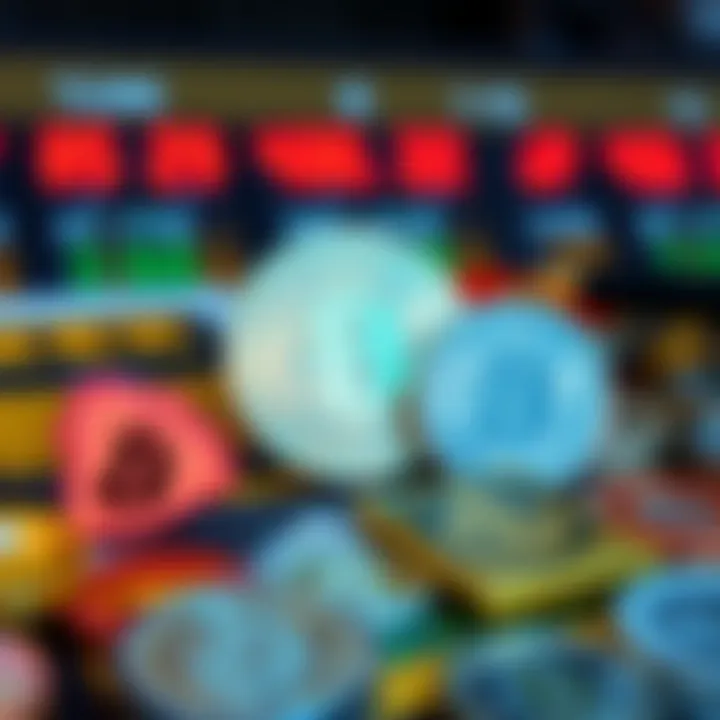Top Cryptocurrency Exchanges Beyond the US


Intro
In the ever-changing landscape of the cryptocurrency world, understanding where to trade your digital assets is crucial. The options available to investors extend far beyond the borders of the United States. This article aims to unravel the potential of cryptocurrency exchanges located outside the US, focusing on aspects such as security, trading fees, and available cryptocurrencies. The unique approaches these platforms take can influence an investor's experience, and choosing wisely might just make the difference between a successful trade and a lost opportunity.
Understanding Cryptocurrency Fundamentals
Before diving into the world of international exchanges, it’s vital to grasp the fundamentals of cryptocurrency and blockchain technology. A solid understanding will not only empower you but also inform your decisions when considering different platforms to trade.
Key Concepts of Blockchain Technology
Blockchain is the backbone of cryptocurrency. It functions as a distributed ledger that records transactions across many computers transparently and securely. This decentralized nature eliminates the need for intermediaries, allowing peer-to-peer transactions to happen smoothly.
- Decentralization: This means that no single entity holds power over the entire blockchain. Each participant has access to the entire chain, making the system more secure and resistant to tampering.
- Cryptography: The security of blockchain relies heavily on cryptographic principles. Each transaction is encrypted, ensuring that only authorized parties can access or alter the data.
- Smart Contracts: These are self-executing contracts with the terms of the agreement directly written into code. They automatically enforce and execute actions when certain conditions are met, paving the way for trustless agreements in a decentralized environment.
Types of Cryptocurrencies and Their Uses
Understanding the different types of cryptocurrencies is essential for any investor. Each coin or token serves a specific purpose, catering to various market needs.
- Bitcoin (BTC): Often regarded as the first cryptocurrency, Bitcoin is primarily used as a digital currency and a store of value.
- Ethereum (ETH): Beyond being a currency, Ethereum facilitates smart contracts and decentralized applications.
- Stablecoins (e.g., Tether): These are pegged to traditional currencies and aim to bring stability to an otherwise volatile market.
- Altcoins: This term generally refers to any cryptocurrency other than bitcoin. They can range in purpose from enabling decentralized finance to supporting specific projects or ecosystems.
Understanding these fundamentals will shed light on the implications when selecting a cryptocurrency exchange.
Analyzing Market Trends
Staying abreast of market trends is pivotal in cryptocurrency trading, especially in a global context. Analyzing market behavior can provide valuable insights into potential future movements and make for savvy investing decisions.
Tools and Techniques for Market Analysis
There is no shortage of tools and techniques available for market analysis. Here are a few vital resources:
- Technical Analysis (TA): This involves statistically analyzing price movements and patterns. Many traders rely on charts and indicators like Moving Averages, RSI (Relative Strength Index), and Fibonacci retracement levels.
- On-chain Analysis: This looks at the data recorded on the blockchain itself, such as transaction volumes or wallet active addresses, which can signal bullish or bearish trends.
- Sentiment Analysis: By gauging community sentiment through platforms like Reddit or Twitter, investors can assess the general mood around specific cryptocurrencies.
Identifying Emerging Trends in Crypto Investing
In keeping pace with the dynamic crypto environment, discerning emerging trends can be a game-changer for investors.
- Regulatory Changes: As different countries implement varying regulations concerning cryptocurrencies, these can influence market dynamics.
- DeFi Growth: The surge in decentralized finance has spurred on a multitude of new projects, often attracting significant investment.
- NFT (Non-Fungible Tokens): The boom of NFTs, often tied to art and digital collectibles, continues to shape market conversations and investment strategies.
Adopting the right approach while navigating these trends can provide investors with the insights necessary for making informed decisions about exchanges operating outside of the traditional U.S. market.
"Knowledge is power. In the world of crypto, it is also wealth."
Investing in cryptocurrencies is not merely a matter of buying low and selling high. Rather, it's about understanding the mechanisms that underlie these digital assets and the exchanges that facilitate their trading. Armed with this understanding, you can better position yourself — both strategically and financially — for the opportunities that await.
Prelude to Global Crypto Exchanges
In the rapidly changing world of cryptocurrency, understanding the landscape of global crypto exchanges is paramount for investors and traders keen on maximizing their opportunities. Choosing the right exchange can not only influence your trading success but also impact security, fees, and the very cryptocurrencies available for trade. In light of the increasing scrutiny and evolving regulations in the United States, many traders are seeking alternatives beyond the U.S. borders. This article aims to illuminate the strengths and weaknesses of exchanges located outside the United States, while keeping a keen eye on factors essential for users.
One of the biggest advantages of exploring these platforms is the diversity they offer. For instance, users often find exchanges that support a broader range of cryptocurrencies, including newer or lesser-known tokens that might not yet be permissible in the U.S. market. This wider selection can be a game-changer for traders looking to capitalize on emerging trends and technologies within the crypto space. Moreover, some platforms boast advanced trading features and lower fees compared to their domestic counterparts, which can lead to more favorable trading margins.
However, navigating global exchanges requires a thoughtful approach. Factors such as the regulatory environment, security measures, and user experience can vary significantly from one region to another. Thus, understanding local regulations is crucial. Each country has its guidelines, and staying informed about their developments can keep an investor compliant while avoiding pitfalls that could arise from oversight.
"In today’s digital arena, the savvy investor is not just knowledgeable but aware of the global implications of their choices."
Another element to consider is security. As recent hacks and breaches have shown, the safety of your digital assets is paramount. Exchange security protocols can differ widely, and it’s wise for users to be proactive in researching how these exchanges safeguard their investments. Users also need to evaluate the user interface and experience provided by these platforms. A clunky or convoluted interface can lead to poor trading decisions, while a smooth, intuitive design can enhance the trading experience.
In summary, diverging from the U.S. crypto exchange market offers unique prospects and challenges. By digging into available options, prospective users can make informed decisions that align with their individual trading goals and comfort level regarding regulation and risk. Engaging thoughtfully with these exchanges can position traders and investors to truly make the most of the global digital asset landscape.
Factors to Consider When Choosing an Exchange
When navigating the crowded field of cryptocurrency exchanges, it’s essential to keep your wits about you. Selecting the right exchange can significantly impact your trading experience, from security to available options. Understanding the factors to consider isn’t just about choosing a platform; it’s about making an informed decision that aligns with your financial goals and expectations.
Regulatory Environment
The first thing you’ll want to consider is the regulatory environment of the exchange. Each country has its own set of laws governing cryptocurrencies, and these can affect everything from transaction security to item cost. Regulatory compliance helps ensure that the exchange operates within legal confines, which can provide credence in the view of investors. Moreover, a regulated exchange often offers some degree of consumer protection, which can make all the difference in turbulent market conditions. In Europe, for example, exchanges need to adhere to the regulations set forth by the EU, ensuring a higher level of transparency compared to unregulated platforms. It’s advisable to check what governing bodies oversee the exchange in question.
Security Protocols
Security is paramount when it comes to trading crypto. Imagine waking up one day only to find your investments gone—nobody wants that! The top exchanges implement multiple layers of security protocols, including end-to-end encryption, regular audits, and withdrawal whitelists. Two-factor authentication (2FA) is another critical component; it adds another barrier for any would-be hackers. Always dig deeper into how an exchange handles your data and funds. Look for reviews on the exchange's history. Have they faced hacks? If so, how did they respond? An exchange's track record in security can be an indicator of how seriously they take your safety.


Fees and Costs
Hidden fees can be the bane of many traders' existence. Before you leap in, take the time to read the fine print about deposit, withdrawal, and trading fees. Different exchanges have different fee structures, with some charging a flat fee and others incorporating variable costs based on trading volume or frequency. Binance, for instance, is renowned for its relatively low trading fees compared to competitors like Coinbase. Understanding these aspects can help save your hard-earned money and maximize your investment returns.
Supported Cryptocurrencies
Not all exchanges are created equal regarding the variety of cryptocurrencies they support. If you're looking to invest in lesser-known altcoins or unique tokens, make sure the exchange offers those options. Some exchanges, like KuCoin, provide an extensive list of cryptocurrencies, giving investors plenty of choices. Conversely, platforms with limited offerings may not cater to your specific investment strategy. Check if your preferred coins are supported before committing.
User Interface and Experience
A user-friendly interface isn’t just a luxury; it’s essential for effective trading. The best exchanges offer intuitive designs that simplify navigation and transactions. Whether you're a novice or a seasoned trader, ease of use can give you an edge in quickly executing trades. It's also worthwhile to consider whether the exchange provides robust mobile features for when you're on the go. A complicated interface can often lead to mistakes, causing financial losses. Assess the user reviews to gain impartially about the overall experience before diving in.
Review of Notable Exchanges Outside the US
As the realm of cryptocurrency continues to expand, it's essential for traders and investors to familiarize themselves with prominent exchanges located outside of the United States. Reviewing these exchanges is significant for various reasons. Primarily, it highlights not only the diverse range of assets and opportunities available globally but also offers insights into different operational methods, regulatory considerations, and unique features.
Navigating through international exchanges may provide options that cater to specific needs, whether that be lower fees, a broader selection of cryptocurrencies, or robust security measures. This section will delve into standout exchanges, analyzing their offerings to help readers discover which platform aligns best with their trading strategies.
Binance
Founded in 2017, Binance swiftly climbed to the top, recognized as one of the largest cryptocurrency exchanges in the world. Its comprehensive selection of over 500 cryptocurrencies sets the stage for experienced traders and novices alike. Binance not only caters to a global audience with various language options but also adapts to different regulatory environments by launching localized versions of its platform.
This exchange boasts advanced trading features, including margin trading and futures, which can be particularly attractive for seasoned traders looking to leverage their investments. However, it's crucial to be aware of Binance's history of regulatory scrutiny in various jurisdictions. This scrutiny often impacts traders' choices, particularly in regions with strict regulations.
Kraken
Kraken is another heavyweight in the crypto exchange arena, known for its robust security features and user-friendly interface. Established in 2011, it remains a go-to platform for institutions and individual investors. An appealing aspect of Kraken is its commitment to regulatory compliance, often reflecting positively on its reputation.
Kraken provides a diverse array of cryptocurrencies and fiat pairings, along with features like futures and margin trading. The platform also prioritizes education, offering thorough resources for users to understand the market landscape better. The trade-offs include higher fees for certain transactions that may sour the trading experience if not accounted for in investment strategies.
Coinbase Pro
Originally known as GDAX, Coinbase Pro is the more advanced trading platform from the renowned Coinbase. Strategically positioned as a professional trading option, it offers lower fees on trades compared to its mainstream counterpart.
Features such as a comprehensive charting tool and a range of order types are major draws for serious traders. Importantly, Coinbase Pro emphasizes security, utilizing industry-leading protocols to safeguard user assets. The platform also provides an intuitive user experience, making it accessible even for those not deeply experienced in trading.
Bitfinex
Bitfinex has established itself as a robust player in the cryptocurrency exchange landscape. With a strong focus on professional traders, Bitfinex offers advanced features such as margin trading and lending. The platform's liquidity has made it popular among high-volume traders.
One must, however, be alert to the platform’s operating history, which includes various controversies and regulatory challenges. Users are often encouraged to conduct thorough research about Bitfinex's practices and security measures before committing their investments.
KuCoin
Known for its vibrant and varied selection of altcoins, KuCoin provides a user-friendly interface along with a plethora of trading options. Launched in 2017, it has quickly garnered a dedicated following among crypto enthusiasts.
The platform frequently lists new cryptocurrencies, allowing users to explore and trade emerging projects before they gain mainstream attention. Of note is KuCoin's appreciation program, rewarding users for participating in the ecosystem, which can incentivize trading activity. Nevertheless, it’s essential to review the exchange's security protocols as well, especially given the dynamic nature of its listings.
Bittrex
Bittrex is often valued for its strict adherence to regulatory compliance and security standards. Launched in 2014, it offers a vast array of cryptocurrencies, making it an attractive option for investors seeking diversified assets.
While the platform has a clean interface, it is often critiqued for its slow customer service response times. For those willing to trade off immediate support for peace of mind regarding security, Bittrex stands out as a considerable option worthy of consideration.
Security Features of Top Exchanges
The landscape of cryptocurrency exchanges outside the United States is as fascinating as it is fraught with challenges. When engaging with these platforms, the security features they offer can mean the difference between a successful trading experience and significant losses. Given the decentralized nature of cryptocurrencies, the responsibility for safeguarding assets falls heavily on both the users and the exchanges themselves. Understanding these aspects becomes vital when wading through the waters of cryptocurrency investing.
To protect their investments, traders should carefully examine the following key security features offered by exchanges:
- Two-Factor Authentication
- Cold and Hot Wallets
- Insurance Policies
Each feature plays a pivotal role in establishing trust and ensuring that your investments are shielded from various threats.
Two-Factor Authentication
Two-factor authentication, often abbreviated as 2FA, has become a non-negotiable security measure in the realm of digital finance. This additional layer of protection requires not only a password but also a secondary verification method, typically a code sent to the user's mobile device. While it might sound like a hassle at times, it significantly reduces the likelihood of unauthorized access to an account.
How does this practically benefit a user? Let’s say you’ve just transferred a substantial amount of Bitcoin to an exchange. If someone somehow gets their hands on your password, they won't be able to access your account without your mobile device. Just like locking your front door but also having a security system, 2FA provides essential peace of mind. As the saying goes, "better safe than sorry," and this principle holds true in the crypto world where hacks and breaches are not uncommon.


Cold and Hot Wallets
Understanding the distinction between cold and hot wallets is crucial for any investor. Hot wallets are connected to the internet, making them more convenient for frequent trading, yet also more vulnerable to hacking attempts. In contrast, cold wallets are stored offline, offering enhanced security against cyber threats.
For example, if you only use a hot wallet, your assets are online and exposed—minding the hot wallet is like leaving your car keys in the ignition while you grab coffee. Cold wallets, such as hardware wallets, require more effort to access, akin to having a safe deposit box; thus, they’re often considered the most secure option for long-term storage of cryptocurrency. The wisdom here is simple: balance accessibility with security, treating crypto assets with the same caution you would with physical currency.
Insurance Policies
Another valuable security feature is the existence of insurance policies that protect user deposits in the event of a breach or hack. Some exchanges provide guarantees that any funds lost due to hacking will be reimbursed up to certain limits, creating a safety net for investors—similar to how traditional bank accounts are federally insured to a degree.
However, not all platforms offer the same level of coverage, and it’s essential to take the time to understand what’s included in a given exchange’s policy. This is especially true for large sums of cryptocurrency. To put it plainly, ask yourself if it’s worth the risk not to make sure your investments are shielded.
"A stitch in time saves nine"—taking precautionary measures now can prevent future headaches.
In summary, security features of exchanges can’t be overlooked when trading cryptocurrencies. As the world of digital assets expands, the potential for risk grows right alongside it. By embracing the tools at their disposal, users can foster safer trading environments and mitigate the inherent risks tied to cryptocurrency investments. Understanding and selecting exchanges according to their security protocols directly impacts how successful and secure one’s trading experience can be.
For further reading on online security practices, visit Wikipedia or explore discussions on Reddit.
Understanding these features deeply allows investors to navigate the crypto market with more confidence.
User Experiences and Feedback
When selecting a cryptocurrency exchange, understanding user experiences and feedback can provide invaluable insight. It can shape your perception and inform decisions that might impact your investment’s success. Unlike textbooks detailing protocols or legal frameworks, user interactions reveal the pulse of an exchange. Personal experiences share the highs and lows of trading, providing more realistic perspectives.
User Reviews
User reviews are like the coffee grounds of a good brew; they offer richness and complexity that you can’t find in surface-level info. They reflect real-life experiences—both the good and the not-so-good. Before diving into any exchange, it’s essential to sift through these reviews to gauge reliability and user satisfaction. You might find comments about the interface being user-friendly or perhaps frustratingly clunky. Prices may be competitive, but if a platform’s trading speed is akin to a sloth in molasses during peak times, that’s a big red flag.
Here's a closer look at what to watch for in reviews:
- Trading Performance: Take note of comments regarding transaction speed. An ideal platform allows quick trading, minimizing delays when market prices fluctuate.
- Accessibility: Determine if users are saying that the platform is easy to navigate. A clunky interface can be a deal breaker, particularly for newcomers.
- Security Concerns: Reviews can shed light on past security breaches. Frequent mentions of poor response to hacks indicate potential pitfalls.
- Withdrawal Experiences: Complaints about long withdrawal times can signal operational issues or may indicate liquidity problems with that exchange.
"Don't put all your eggs in one basket, but do listen to what other egg collectors have to say." - anonymous trader
Customer Support Services
Customer support can be the unsung hero of the exchange world. When currency is involved, quick and helpful responses are critical. Encountering an issue can throw a wrench in your investing strategy, so having reliable customer support is key. Many investors often overlook this aspect, thinking they can fend for themselves, but that could be a costly mistake.
Consider the following dimensions when scrutinizing customer support:
- Availability: Are they available 24/7? If not, and you are trading across global markets, you could find yourself stuck during non-business hours.
- Response Time: Fast reply times ought to be highlighted in user feedback. Waiting hours or, worse, days for a response during a volatile market, can be detrimental.
- Channels of Communication: Look for diverse options such as live chat, email, and phone support. A platform offering multiple contact methods can provide greater flexibility when issues arise.
- Resolution Effectiveness: Positive feedback on how swiftly and effectively issues were resolved indicates solid support that might save you headaches in the future.
In summary, the experiences shared by users paint a clearer picture than the promotional material on a platform's website. By delving into user feedback and reviews, you can cut through the marketing fluff and get to the heart of an exchange's reliability and functionality.
Comparative Analysis of Fees
Understanding the fees associated with cryptocurrency exchanges is akin to reading the fine print before signing a contract. Depending on the exchange, these fees can significantly affect your overall trading profitability. Fees can encompass various forms including deposit fees, withdrawal fees, and trading fees, each bringing its own sets of advantages and considerations. A thorough analysis of these fees is crucial, especially for investors looking to optimize their trading strategies and manage costs effectively.
Investors should take into account how fees can be a make-or-break factor for numerous trading activities. If you’re trading frequently, high trading fees can slice into profits like a hot knife through butter, rendering your efforts less rewarding. Likewise, deposit and withdrawal fees can pose additional hurdles. Assessing fee structures not only aids in selecting an exchange but also enhances one’s understanding of the overall cost landscape.
Deposit and Withdrawal Fees
Deposit and withdrawal fees are often overlooked but can accumulate significantly over time. Some exchanges may charge a flat fee for deposits, while others might apply variable fees based on the payment method. If you choose to fund your account with a credit card, for instance, fees might be higher compared to bank transfers.
Here are a few key points to consider regarding deposit and withdrawal fees:
- Payment Method Variability: Different payment methods will often incur different fees. Credit and debit cards may have higher fees than bank transfers or cryptocurrency deposits.
- Crypto vs. Fiat: Withdrawing cryptocurrency might be cheaper than withdrawing fiat currency. Understanding these nuances can help you save money in the long run.
- Minimum Withdrawal Amounts: Some exchanges set a minimum withdrawal limit. If you don’t meet this threshold, you'll be forced to leave funds in your account, potentially losing them to unwanted trading fees.
Assessing these fees gives you a clearer picture of your net gain, making appropriate adjustments in your investment strategy.
Trading Fees Structures
Trading fees are where many exchanges can hit you hard if you’re not careful. These fees can come in various forms, like market maker fees, taker fees, or flat rates. A deeper understanding here is important, particularly as trading volumes increase.
- Maker vs. Taker Fees: Most exchanges operate on a maker-taker model. Makers provide liquidity to the market, while takers remove it. As a general rule, maker fees tend to be lower than taker fees. If you’re often in and out of trades, this distinction can influence your trading choices.
- Tiered Fee Structures: Some exchanges offer tiered fee pricing based on your trading volume. Higher volume trades can qualify for reduced fees, which can be a boon for frequent traders.
- Flat Fees vs. Percentage Fees: It’s also plausible to encounter both flat-rate fees and percentage-based fees. Understanding which method your exchange utilizes can be important in forecasting potential costs.
Ultimately, evaluating these fee structures gives traders leverage in decision-making and strategy formation. It sheds light on the potential pain points within your trading routine, allowing for shrewder financial moves.
"Fees are like taxes on trades; make sure you know what you’re paying to avoid unpleasant surprises."


Regional Considerations in Exchange Selection
Understanding regional considerations in selecting a crypto exchange is critical for anyone navigating the vast landscape of cryptocurrency trading. Different regions present unique regulatory environments, cultural attitudes towards cryptocurrency, and varying technological infrastructures. Investors need to grasp these elements because they can significantly influence everything from security measures to the types of cryptocurrencies supported.
Choosing an exchange isn't just about the platform's technical aspects or user interface; it's also about how those elements resonate with specific local conditions. Recognizing these factors allows traders to align their strategies accordingly, enhancing their overall trading experience while mitigating risks.
Europe
Europe stands out as a significant hub for cryptocurrency exchanges, largely due to its well-established regulatory framework. Many European countries have embraced crypto with open arms, albeit with a firm hand. The European Union continually evolves its policies around trading, often fostering an environment of innovation while ensuring consumer protection. Different countries such as Germany and France have implemented comprehensive mechanisms to regulate digital assets. These approaches can inspire confidence among users, assuring them that there are safeguards in place when trading.
A notable benefit for users in Europe is access to several top-tier exchanges. Platforms like Bitstamp and Kraken often yield trust with mature user bases. Additionally, the presence of multiple fiat currencies, including the Euro, allows for seamless conversions and trading experiences. Nevertheless, users must pay attention to local laws, as restrictions can vary widely between nations.
"As Europe continues to refine its stance on cryptocurrencies, traders should stay informed on local regulations that may impact their operations and strategy."
Asia
Asia is another crucial region for crypto trading, housing some of the world's leading exchanges. Countries like Japan and South Korea are pioneers in integrating new technologies within the crypto space. The Asian market tends to be dynamic, with a high appetite for fintech innovations. This climate fosters rapid growth, but it can also introduce unpredictability. For instance, regulations are being introduced in waves, reflecting ongoing discussions between governments and technology firms about the crypto's future.
Platforms like Binance and Huobi are dominant players, offering a vast range of altcoins that often aren't available on exchanges located elsewhere. Such diversity can be advantageous for investors looking to explore lesser-known cryptocurrencies that might offer considerable upside. Nonetheless, one must always be cautious due to the sometimes opaque nature of regulations.
Finally, cultural perspectives on crypto also vary across Asia. In some countries, crypto is seen as an opportunity for prosperity, while in others, it may be viewed with skepticism. Engaging in local communities and understanding these different attitudes can be key to navigating the exchange landscape successfully.
South America
In South America, the cryptocurrency landscape is evolving but still faces several challenges. Various economic issues, fluctuation in fiat currencies, and varying regulatory approaches can complicate trading in this region. However, many nations are beginning to recognize the utility of blockchain technology, resulting in a gradual shift toward more robust crypto policies.
Brazil and Argentina have emerged as particularly interesting markets. In these countries, cryptocurrencies provide alternative solutions for citizens battling inflation and economic instability. Exchanges like Mercado Bitcoin in Brazil offer a more localized approach that caters specifically to the market's needs. Nevertheless, users should be mindful of the fact that regulation may not yet be as comprehensive as in Europe or Asia, potentially leading to risks around security and service reliability.
The growth in crypto adoption is also being fueled by grassroots movements and tech-savvy youth. Blockchain initiatives are starting to take root, hinting at a fresh wave of innovation that could further enhance the trading environment.
Future Trends in Crypto Exchanges
The landscape of cryptocurrency exchanges is continuously evolving, shaped by shifts in technology and market sentiment. In this section, we will delve into two significant aspects influencing these exchanges: regulatory developments and technological innovations. Understanding these trends is essential for investors and traders alike, as they hold the key to navigating future challenges and harnessing opportunities in the ever-changing crypto space.
Regulatory Developments
Regulations surrounding cryptocurrency exchanges vary wildly across different countries and regions. As authorities seek to protect investors and stabilize financial markets, we can expect more structured and stringent rules to emerge in the coming years.
For instance, recent discussions among European Union officials aim to create a unified regulatory framework for cryptocurrencies. This could streamline adherence for exchanges operating across member states and enhance consumer trust. A well-defined regulatory environment provides clarity and can foster innovation; hence, crypto exchanges may find themselves adapting swiftly to comply with these regulations.
One important point to consider is that an uptick in regulations might lead to the exit of unregulated or less compliant exchanges, consolidating the market. This could push exchanges to prioritize compliance, leading to improved security measures and transparent practices. It's vital for traders to stay informed about these developments, as they might significantly impact trading strategies and exchange reliability.
"Regulations can act as a double-edged sword; while they can provide safety nets for traders, they can also stifle innovation if overly restrictive."
Technological Innovations
In tandem with regulatory changes, technology advances are pushing crypto exchanges into new territories of efficiency and security. A notable trend is the rise of Decentralized Exchanges (DEXs), which allow users to transact directly with one another without intermediaries. This eliminates the need for trust in a central authority, potentially offering a safer trading environment.
Moreover, advancements like Artificial Intelligence are being integrated into trading systems to enhance predictive analytics, enabling better decision-making for traders. AI tools can help in recognizing market patterns and executing trades automatically based on set parameters.
Here are some key technological trends to watch for:
- Blockchain Interoperability: Technology that allows different blockchains to communicate effectively will likely gain traction, enabling more fluid cross-chain trading.
- Enhanced Security Solutions: The ongoing threat of hacking means exchanges will need to adopt more robust solutions like biometric authentication and multi-signature wallets.
- User-Centric Innovations: Adapting to user preferences will lead exchanges to develop more tailored interfaces, improving user experience and attracting new clients.
Keeping an eye on these technological liberties could prove advantageous for crypto enthusiasts. As these innovations unfold, those who adapt swiftly will likely outperform others in gains and user satisfaction.
Epilogue
As we wrap up our exploration into the world of cryptocurrency exchanges beyond the borders of the United States, it becomes clear that selecting the right exchange is not just a matter of convenience but rather a decision that can significantly influence one's trading success. Throughout this article, multiple factors have been discussed, each integral to understanding the global crypto landscape.
Importance of Well-Informed Choices
The first consideration is the regulatory environment. Navigating through different laws can feel as confusing as finding a needle in a haystack, yet it’s crucial for security and compliance reasons. Investors need to pay attention to how exchanges comply politically and legally in their respective countries. An exchange that operates under stringent regulations is often a safer bet for users.
Next, there’s the aspect of security protocols. In a space rife with risks, investors must ensure that an exchange employs robust security measures. From two-factor authentication to the use of cold wallets, these features are the bedrock of trust. When users take precautions to protect their assets, they can feel more secure participating in trading activities.
Another key point revolves around fees and costs associated with trading. As a savvy trader, understanding the fee structures can mean the difference between profit and loss. Taking time to dissect an exchange’s deposit and withdrawal fees, as well as trading commissions, is a task that can reap rewards.
User experience is also paramount. A complex interface can frustrate even the most experienced trader. Users should find exchanges that offer intuitive interfaces that can ease the trading experience, making it more accessible.
Lastly, as we gaze into the future, technological innovations will continue transforming these exchanges. Staying updated with future trends is not just smart; it's necessary. As crypto evolves, keeping an eye on shifts in the marketplace will deliver valuable insights for strategic decisions.
"The right exchange could be your best tool to thrive in the crypto economy."
In summary, the concluding chapter here emphasizes that every decision related to cryptocurrency trading should stem from meticulous research and an understanding of the combined elements discussed in this article. As the crypto sphere continues to develop at a dizzying pace, being prudent in selecting exchanges will pave the way for informed, strategic trading—making a compelling case for the importance of this very topic.















